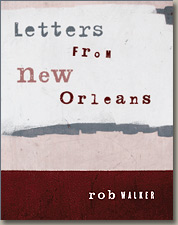 Sorry for the melodramatic headline. But “coupla stray notes” didn’t seem adequate.
Sorry for the melodramatic headline. But “coupla stray notes” didn’t seem adequate.
First: Shortly after returning from our trip to N.O. in connection with the very enjoyable Hypothetical Development Organization opening, I was pleased to receive in the mail the book Louisiana Rambles: Exploring America’s Cajun and Creole Heartland, by Ian McNulty. I managed to sped a bit of time with it this weekend, and enjoyed what I read quite a bit. There’s a piece about the holiday bonfires upriver (also subject of an essay in LfNO), and a nice travelogue about the Angola rodeo — something we attended and I always wish I had written about… but I never did. There are also several pieces about exploring the musical culture of regions around N.O. that I haven’t yet read but am really looking forward to, because those are adventures we never quite found time for during our time in the area.
Anyway I intend to make more use of Mr. McNulty’s observations and explorations on our next trip to Louisiana.
Second note: Another essay in LfNO, which I’ve referred back to often, concerned Claiborne Avenue and I-10. I’ve mentioned there’s talk of somehow reverting this area to some sort of pre-Interstate version of itself (presumably by destroying the freeway, that’s my excuse for the “destruction” headline), but I see from this T-P article that the current state of things is that a study is still being planned. There’s something very New Orleans about that…






 A couple of years ago I did some research into the song "St. James Infirmary," wrote up what I found, emailed that essay to friends and posted it on my web site (as part of a series of "Letters From New Orleans," as I was living in that city at the time). Based on the feedback, I wrote a second version of the essay, and asked for more feedback. Based on that, I wrote a
A couple of years ago I did some research into the song "St. James Infirmary," wrote up what I found, emailed that essay to friends and posted it on my web site (as part of a series of "Letters From New Orleans," as I was living in that city at the time). Based on the feedback, I wrote a second version of the essay, and asked for more feedback. Based on that, I wrote a 
